
Perineorrhaphy Surgery: Who Needs It, and How It Helps Improve Pelvic Health
Perineorrhaphy surgery has become an increasingly recommended procedure for women who experience postpartum perineal trauma, pelvic floor weakness, or discomfort […]
Laser treatments have revolutionized the field of medical and aesthetic procedures, offering effective solutions for various skin conditions and cosmetic […]

Laser treatments have revolutionized the field of medical and aesthetic procedures, offering effective solutions for various skin conditions and cosmetic enhancements. This article provides a detailed overview of different types of lasers, their applications, leading countries, advancements, methods, certifications, side effects, efficacy, and expert opinions.
Laser treatments use focused light energy to target specific tissues in the body. The term “laser” stands for “Light Amplification by Stimulated Emission of Radiation.” Different types of lasers are used in various medical and aesthetic treatments, each designed to address specific concerns.
Ablative lasers work by removing the outer layers of the skin, promoting the regeneration of new skin cells. They are used for:
Examples: CO2 lasers, Erbium YAG lasers.
Non-ablative lasers penetrate the skin without removing the outer layer, stimulating collagen production and tightening the underlying skin. They are used for:
Examples: Nd lasers, Alexandrite lasers, Pulsed Dye lasers.
Fractional lasers deliver laser energy in a grid pattern, treating microscopic columns of skin while leaving surrounding tissue intact. They are used for:
Examples: Fraxel lasers, Fractional CO2 lasers.
Q-switched lasers deliver short, high-energy pulses to break down pigments in the skin. They are used for:
Examples: Q-switched Nd lasers, Q-switched Ruby lasers.
Fotona lasers are renowned for their versatility and effectiveness in both medical and aesthetic treatments. They are used for:
Examples: Fotona SP Dynamis, Fotona XS Dynamis.
Laser hair removal is a popular non-invasive treatment that uses lasers to target and destroy hair follicles, preventing future hair growth. Different lasers used for hair removal include:
lasers, Alexandrite lasers, and Diode lasers are more versatile and can be used on a wider range of skin tones and hair types.

lasers.
are safe for darker skin tones.
Common side effects of laser treatments include:
Laser treatments are highly effective for a range of conditions, with many patients experiencing significant improvements. The efficacy depends on:
Several countries are renowned for their expertise in laser treatments, offering advanced technology and skilled professionals:
Laser technology is continually evolving, with ongoing research aimed at improving efficacy and safety. Recent advancements include:
Patients and specialists often share positive feedback about laser treatments, highlighting their effectiveness and minimal downtime. Testimonials from satisfied patients emphasize improved skin appearance, reduced scars, and enhanced self-confidence.
Patient Testimonial:
1: What are the different types of lasers used in skin treatments?
Common types include ablative lasers (CO2, Erbium YAG), non-ablative lasers (Nd
, Alexandrite), fractional lasers (Fraxel), and Q-switched lasers (Nd, Ruby).
2: Are laser treatments safe for all skin types?
Advanced lasers like Nd are safe for darker skin tones, while others like Ruby lasers are better suited for lighter skin. It’s essential to consult with a specialist to determine the best laser for your skin type.
3: What should I expect during a laser treatment session?
Expect a consultation, local anesthesia if needed, the laser application, and post-treatment care instructions. Sessions typically last between 30 minutes to an hour.
4: How many sessions are needed for laser hair removal?
Most patients require 6-8 sessions for optimal results, with maintenance sessions as needed.
5: What are the common side effects of laser treatments?
Side effects include redness, swelling, mild discomfort, and temporary pigment changes. These are usually short-lived and resolve within a few days.
Laser treatments offer a versatile and effective solution for various medical and aesthetic concerns. With advancements in technology and ongoing research, these procedures continue to improve, providing patients with safe and efficient options for skin rejuvenation and other treatments. When considering laser treatments, it is essential to choose a qualified specialist and follow pre- and post-treatment care instructions to achieve the best possible results. Leading countries like the United States, Germany, South Korea, Brazil, Turkey, and Iran provide excellent options for those seeking high-quality laser treatments.
Summary